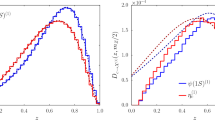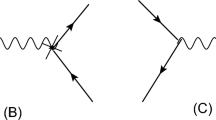Abstract
The dominant mechanism to produce hadronic bound states with large transverse momentum is fragmentation, that is the splitting of a high-energy parton into a hadronic state and other partons. We review the present schemes to calculate the heavy quark fragmentation functions (FFs) and derive an exact analytical expression of FF which includes most of the kinematical and dynamical properties of the process. Using the perturbative QCD, we calculate the FF for c-quark to split into S-wave D+ meson to leading order in the QCD coupling constant. Our result is compared with the current well-known phenomenological models which are obtained through a global fit to e + e − data from SLAC SLC and CERN LEP1 and we also compare the FF with experimental data form BELLE and CLEO. Specifically, we study the effect of outgoing meson mass on the pQCD FF. Meson masses are responsible for the low-z threshold, where z is the scaled energy variable.
Similar content being viewed by others
References
M. Hirai, S. Kumano, Prog. Theor. Phys. Suppl. 186, 244 (2010).
V.N. Gribov, L.N. Lipatov, Sov. J. Nucl. Phys. 15, 438 (1972) (Yad. Fiz. 15.
B. Mele, P. Nason, Nucl. Phys. B 361, 626 (1991).
M. Cacciari, S. Catani, Nucl. Phys. B 617, 253 (2001).
Studies on fragmentation functions are listed in http://www.pv.infn.it/~radici/FFdatabase/.
S. Albino, B.A. Kniehl, G. Kramer, Nucl. Phys. B 725, 181 (2005).
B.A. Kniehl, G. Kramer, B. Potter, Nucl. Phys. B 582, 514 (2000).
T. Kneesch, B.A. Kniehl, G. Kramer, I. Schienbein, Nucl. Phys. B 799, 34 (2008).
P. Nason, C. Oleari, Nucl. Phys. B 565, 245 (2000).
M. Cacciari, P. Nason, C. Oleari, JHEP 04, 006 (2006).
J.C. Collins, Phys. Rev. D 58, 094002 (1998).
C. Peterson, D. Schlatter, I. Schmitt, P.M. Zerwas, Phys. Rev. D 27, 105 (1983).
B. Andersson, G. Gustafson, G. Ingelman, T. Sjostrand, Phys. Rep. 97, 31 (1983).
B.R. Webber, Nucl. Phys. B 238, 492 (1984).
J.P. Ma, Nucl. Phys. B 506, 329 (1997).
E. Braaten, T.C. Yuan, Phys. Rev. Lett. 71, 1673 (1993).
C.-H. Chang, Y.-Q. Chen, Phys. Lett. B 284, 127 (1992).
E. Braaten, K.-m. Cheung, T.C. Yuan, Phys. Rev. D 48, 4230 (1993).
D.M. Scott, Phys. Rev. D 18, 210 (1978).
J.D. Bjorken, Phys. Rev. D 17, 171 (1978).
M. Suzuki, Phys. Lett. B 71, 139 (1977).
F. Amiri, C.-R. Ji, Phys. Lett. B 195, 593 (1987).
P. Nason, B.R. Webber, Nucl. Phys. B 421, 473 (1994) 480.
B.A. Kniehl, G. Kramer, I. Schienbein, H. Spiesberger, Phys. Rev. D 84, 094026 (2011).
M.G. Bowler, Z. Phys. C 11, 169 (1981).
Belle Collaboration (R. Seuster et al.), Phys. Rev. D 73, 032002 (2006).
J. Binnewies, B.A. Kniehl, G. Kramer, Phys. Rev. D 58, 034016 (1998).
M. Suzuki, Phys. Rev. D 33, 676 (1986).
G.P. Lepage, S.J. Brodsky, Phys. Rev. D 22, 2157 (1980).
M.A. Gomshi Nobary, J. Phys. G 20, 65 (1994).
A.D. Adamov, G.R. Goldstein, Phys. Rev. D 56, 7381 (1997).
S.J. Brodsky, C.-R. Ji, Phys. Rev. Lett. 55, 2257 (1985).
F. Amiri, B.C. Harms, C.-R. Ji, Phys. Rev. D 32, 2982 (1985).
G. Corcella, G. Ferrera, JHEP 12, 029 (2007).
S. Albino, B.A. Kniehl, G. Kramer, W. Ochs, Phys. Rev. D 73, 054020 (2006).
Particle Data Group (K. Nakamura et al.), J. Phys. G 37, 075021 (2010).
Author information
Authors and Affiliations
Corresponding author
Rights and permissions
About this article
Cite this article
Mohammad Moosavi Nejad, S., Armat, A. Heavy quark perturbative QCD fragmentation functions in the presence of hadron mass. Eur. Phys. J. Plus 128, 121 (2013). https://doi.org/10.1140/epjp/i2013-13121-2
Received:
Accepted:
Published:
DOI: https://doi.org/10.1140/epjp/i2013-13121-2




